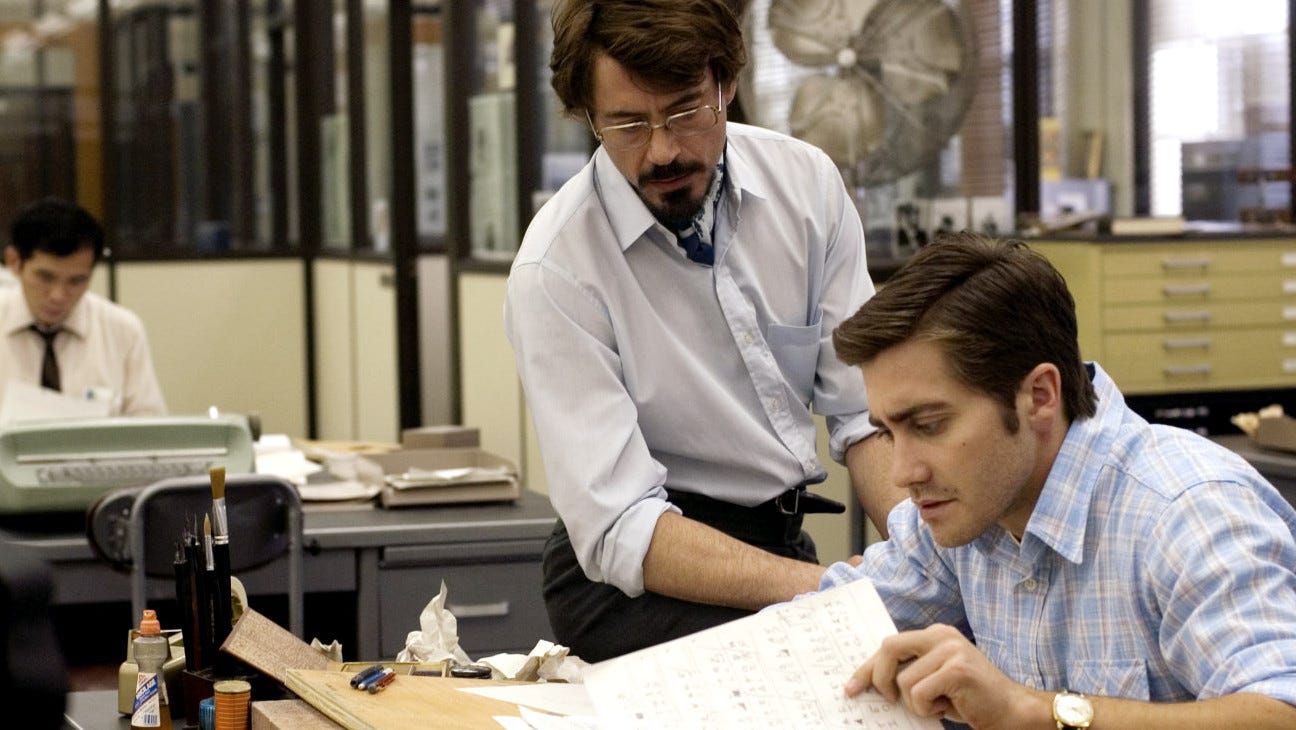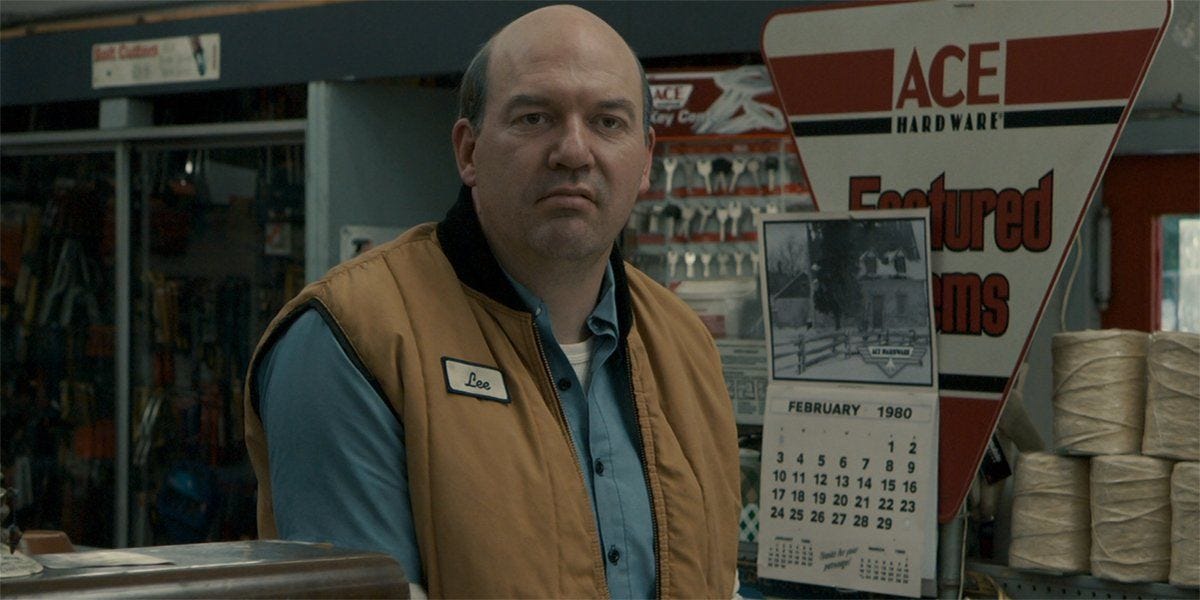The Favourites
Zodiac
In a career with many great films, 2008’s Zodiac stands as David Fincher’s totemic masterpiece. A sprawling, all encompassing portrait of a city in danger, the film not only perfectly captures the fear that the Zodiac killer was able to produce, but the obsession of the current true crime culture. Featuring career best performances from many of the cast, including Mark Ruffalo and Robert Downey Jr., and featuring a rogues gallery of fantastic character actors, the craft on display is formidable to say the least. But it’s in Fincher’s portrayal of fear and our morbid obsession with the horror of psychopathy that the film truly becomes one of the greatest of the 21st century.
Much of the film is dedicated to a retelling of the murders of the Zodiac Killer as accurately as possible. The meta-textual research that Fincher and writer James Vinderbilt put into crafting the script is important to know, as their research structure influenced the structure of the film. Everything we are shown in the film involving the murders involves having a surviving witness and accounts from people at the time. This gives the murders an eerie sense of reality, as while there is plenty of violence in films, few are given the weight that attacks shown here are given. Through portraying these acts as accurately as possible and through the eyes of the real people who experienced them, Fincher is able to thoroughly explore the fear that permeated the community at that time.
This is further explored with the accurate portrayal of police procedures at the time. While at no point are we lead to believe the police did not take the Zodiac case seriously, we are shown the frustrating bureaucracy that hampered the case. Jurisdictional pissing contests and miscommunications lead to multiple law enforcement offices leading parallel cases but not sharing information between each other, leaving it for Robert Graysmith (Jake Gyllenhaal) to eventually be the one to make the connections years after the case had gone cold. It’s through the accuracy of the era, both in the murders and the investigation, that Fincher sets his hooks in us to pull us along for the reminder of the film.
Despite entering the film (most likely) knowing that the Zodiac was never caught, the audience wants to believe they’ll see something that got missed. They want to be the person who solves the case, and by using such accurate sources and staging the film with a veneer of accuracy, Fincher is playing into this belief. If only we look closely enough and think clearly enough, the truth of the case will unveil itself. But this is a trick, a ploy by Fincher, getting us invested beyond the bounds of the frame. The truth is unknown, and through his filmmaking he’s able to make the mystery as haunting today as it was going unsolved in the 1960s.
Even though the film carries the facade of truth, and the research done for the film was very well covered, it is a facade nonetheless, and it’s in the separation of truth and art that the film excels. Fincher’s use of the 1968 Donovan track “Hurdy Gurdy Man”, used in correlation with the first murder, brings us into this bizarre world of overt and senseless violence that seems so foreign to our reality. The song is period accurate yet otherworldly, it’s psychodelia influences leading us through a terrifying descent into 1960s San Francisco. It’s true and false rolled into one, the fact of the murders and the artifice of the mélange of music, editing, lighting, everything that had to be decided by Fincher.
The score and soundtracking of the film elevates the horror of the film greatly. Composer David Shire uses sparse instrumentation to focus on the isolation of the city. San Francisco and the Bay area have millions of people, yet every scene in the film shows lonely and distant people. There is a fracturing of community that is taking place even before the first murder, as the first couple is shown to be acting against social norms. The woman insists on driving, much to the chagrin of her younger lover. They are also committing adultery, showing the fracturing of a marriage. While these are both facts of the case, by emphasizing these moments in the film Fincher is showing a fractured city. In the dark and foreboding cracks of this world, the Zodiac Killer has taken purchase.
The role of the police in the film is that of the failed reconstructionist, the people tasked with putting the pieces back together after the killer has broken everything. The failures in their communication, and ultimately their investigation, symbolizes that there is no returning to a world they believed was great. The rise of serial killers in the 60s and 70s showed an America that was not the bright and shining city on the hill. While the 1950s showed prosperity for the white middle class across the country, while many minority groups and people who didn’t fit in the social norms of the time were waylaid and left behind. The art of the time either reflected back this picture perfect mirage (such as in television hits Leave It to Beaver and I Love Lucy) or preferred to take a light stance against the exploitations of the time. But there was only so much crumbling plaster and false smiles that could hold that facade of America together, and by the 1960s the rosy cheeked Rockwellian world was no more. Zodiac shows the failures of idealism and the darkness that is allowed to fester in the underbelly of an inattentive society.
The corrupting influence of the Zodiac Killer is best seen through it’s influence on Robert Graysmith. When we meet him, Graysmith is a wide-eyed keener. The cartoonist for the San Francisco Chronicle, he’s at the offices when the first Zodiac letter arrives but is dismissed and ignored from all discussions involving what to do in response to the letter. We see that he’s immediately interested in the case, and it’s these seeds planted in the early days of the investigation that eventually grow into his lifelong obsession. And throughout these early days (and his eventual investigation) he’s referred to as the symbolic American angel, the Boy Scout. Graysmith is as pure a person one is likely to get in the world of Zodiac, and so his eventual fall into obsession is the greatest fall of all.
I... I need to know who he is. I... I need to stand there, I need to look him in the eye, and I need to know that it's him. - Robert Graysmith
While his obsession starts small, it eventually takes over his entire life and leads him into increasingly dangerous situations. His wife eventually leaves him after he refuses to stop, and he begins to receive silent phone calls at all hours of the day. The pinnacle of this behavior is when he goes to visit a man he believes may have information on a suspect, only to discover the man himself fits the profile of the killer. As the conversation continues and Graysmith is eventually asked to join the man (Charles Fleischer) in his basement to find some old film posters, Graysmith flees. It’s only at this moment that he has realized not just what his obsession has already taken from him, but what it could take from him. His fall from Boy Scout is completed, and while he does eventually release a book about the Zodiac Killer, he broke free from his tireless pursuit.
While Graysmith is the character who is broken most by his pursuit of the Killer, he is not the only one left scarred by the mystery. Paul Avery (Robert Downey Jr.) leaves his job at the newspaper and falls into alcoholism after being called out directly by the Zodiac. David Toschi (Mark Ruffalo) loses his long time partner William Armstrong (Anthony Edwards) when Armstrong decides to move precincts out of fear of the killer. Toschi himself is haunted by the case, believing that he had the right man only to be stonewalled. This is all without mentioning the Zodiac’s direct victims, including the survivor we close the film on Mike Mageau (Jimmi Simpson) who has spent his life in fear because of the attack that nearly claimed his life as a teenager. The film is about the destruction wrought by a single man, and the lives forever changed by his horrific actions.
The last time I saw this face was July 4th, 1969. I am very sure that's the man who shot me. - Mike Mageau
The creeping dread of the film is not just sensed or affecting of the characters, but of the audience as well. Through Fincher’s staging and framing, we are brought into this world and face-to-face with possible murderers throughout the film. In the interrogation scene with Zodiac suspect Arthur Leigh Allen (John Carroll Lynch), at multiple points throughout the scene Allen is speaking while looking directly into the camera. The framing is traditional for both the detectives asking questions, only switching to this down-the-barrel view when Allen is answering, as if he is speaking directly to us at home. As he is put forward as the most likely culprit, it’s in these moments that we become much like Robert Graysmith; obsessives, looking for answers and clues we’ll never find, being confronted with a danger we only have a general idea of.
Zodiac is a masterpiece of design and storytelling, and one that helped usher in the current trend of true crime media obsession. While blood and guts have often made the front page of newspapers, it feels like we’re more and more inundated with stories of despair daily. We’ve taken horrible truths of this world and transformed it into digestible content. The worst day of your life will be entertainment for the masses tomorrow. Fincher saw this coming, and in Zodiac made us culpable, made us feel the terror that is so quickly forgotten as the years go by and the story is told again and again. A film about a degraded America birthing a villain, and the world that continues to give him a stage to this day.







